Earlier this year, my friend and photographer Philipp Heer and I explored Munich. We were fascinated by its museums, contemporary religious architecture and U-Bahn stations – to name a few. Simply Munich had invited us to spend a couple of days exploring and capturing the city from its many angles, and thanks to the brilliant planning of the team (Danke schön Frauke!) and a car, we managed to cover a great deal of locations.
Philipp and I travel for architecture. We spend months researching a city; scouting buildings, tracking the most obscure and secret locations, and scrutinising angles to capture these structures in their full splendour. But we are always dazed when we are in person.
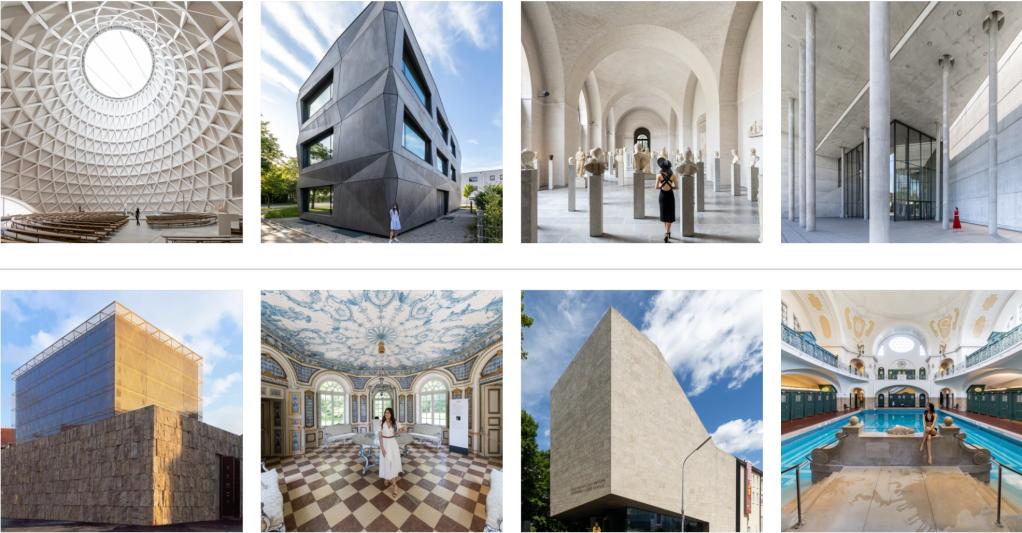
Munich – Bavaria’s capital – is a city with a complicated history. Its many layers of happenings, however, have enriched the urban fabric beyond belief. From synagogues to churches. Public baths and private collections. Vast areas of greenery and confined – but delightful – pavilions in them. Though not acknowledging Munich’s beer wonders would be wrong, the only mention of this substance would be in the stunning buildings (like the new Paulaner HQ by Hierl Architekten) that contain them. Yes, other aspects of the city are grandiose, but its architecture is truly extensive and marvellous, so I’ll only focus on that.
We hope this list serves as a teaser for your future travels. Please find the map containing all locations at the end of this article.
1. Juristische Bibliothek
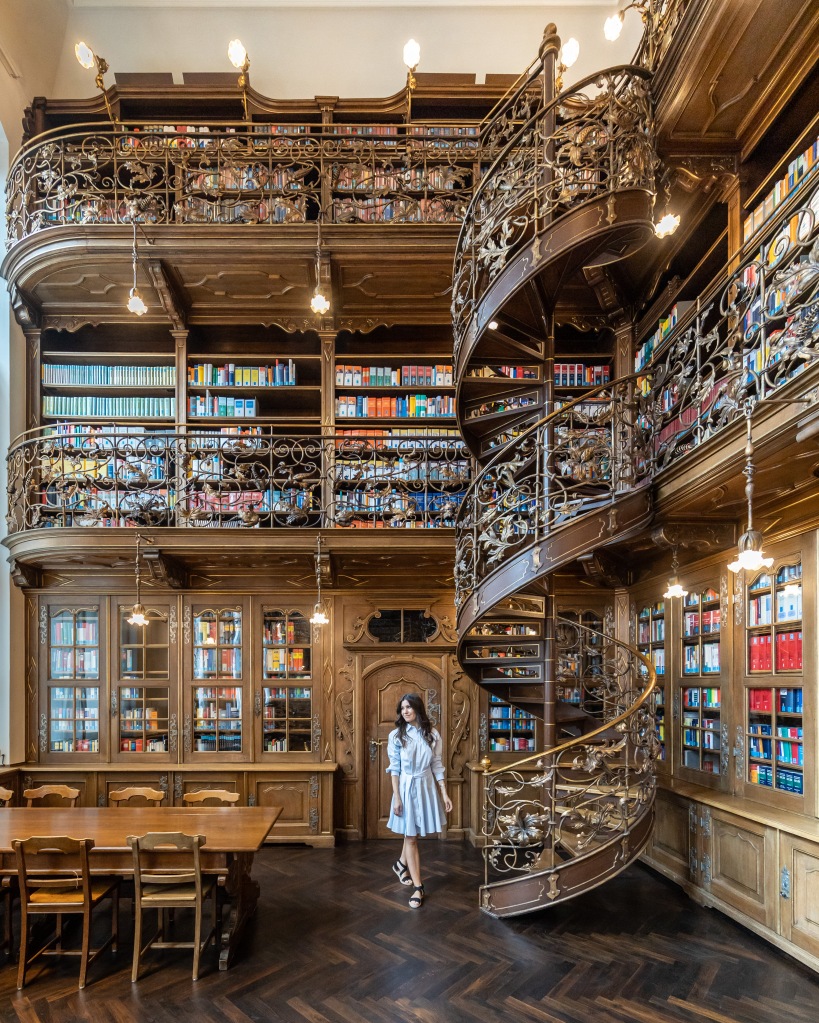
Of all Munich’s sites, no other represents the city’s spirit like the Neues Rathaus. Located at the very heart of Marienplatz, it has become one of the most famous buildings in Munich. But you will have to go inside to find the true gem of the complex: The Juristische Bibliothek by Georg von Hauberrisser. Hidden away in the New Town Hall, the Legal Library is one of the most stunning libraries in the world, and one of Munich’s best kept secrets. The Juristische Bibliothek is a beautiful art nouveau library decked out with wrought-iron spiral staircases and multiple stories of colourful books popping from the shelves – a delight to visit. It’s open to the public, but not really for sightseeing. If you want to come read or explore the collections, standard Munich library rules apply (leaving your stuff in lockers outside), but if you want to come for photos and sightseeing, you must do so through a guided tour of the Rathaus. Read more here.
Architect: Georg von Hauberrisser
Location: Marienplatz 8, 80331 München (Google)
Year: 1906
2. Museum Brandhorst
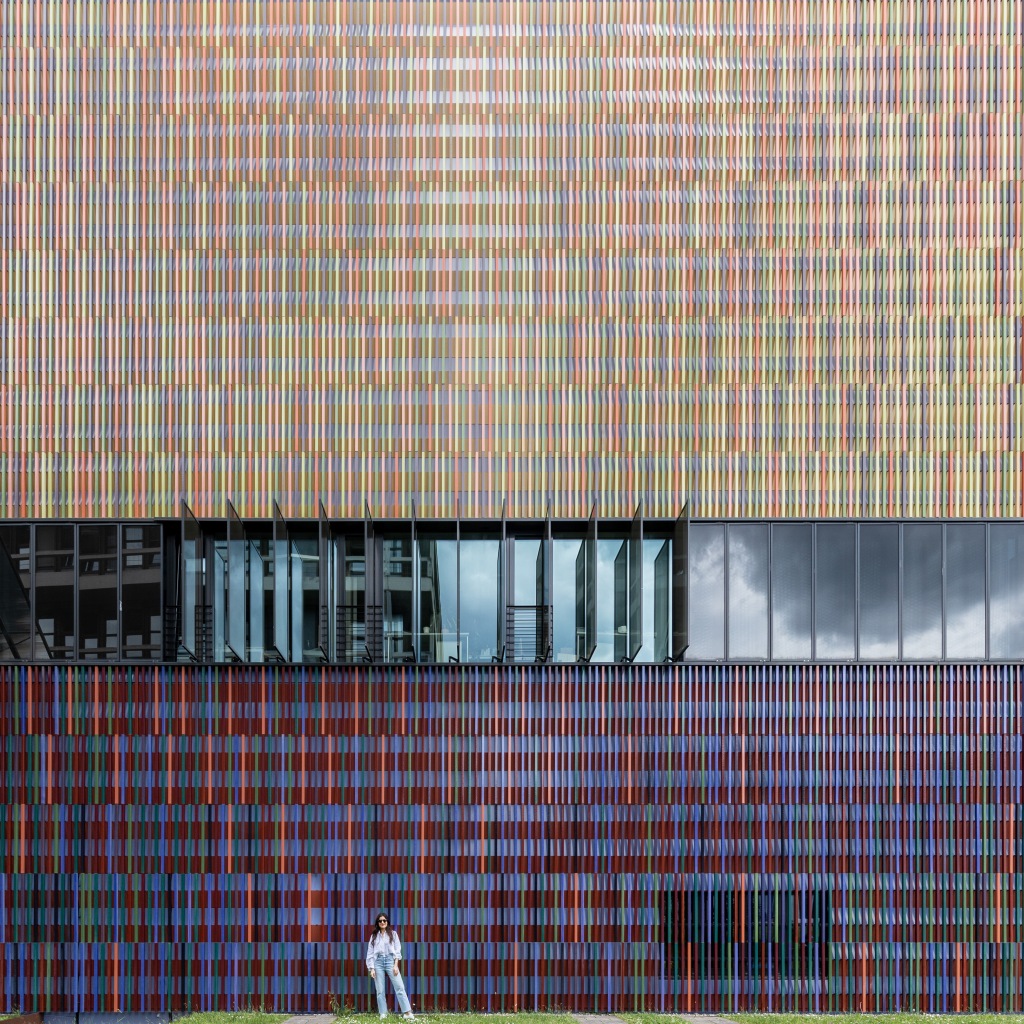
Despite its smaller scale in comparison to the other museums in the area, Museum Brandhorst is one of the most interesting. The building consists of a long volume that lines the street and a taller one that marks the north-eastern corner of Munich’s museum quarter. These are both clad in a textured and polychromatically treated skin, whose gradations in hue and tone give the building the appearance of three simple interlocking volumes. Embodying the principle of kinetic polychromy, this lends the building a dynamic appearance with countless gradations between a smooth – almost dematerialised – impression when seen from afar and one of a three-dimensional woven structure from close proximity. The Brandhorst Museum houses a substantial private collection of late 20th-century and contemporary art, predominantly paintings. Like a vast abstract painting, the façade communicates the spirit of the museum as a place where art comes alive. Read more here.
Architect: Sauerbruch Hutton
Location: Theresienstraße 35a, 80333 München (Google)
Year: 2009
3. U-Bahn stations – Westfriedhof
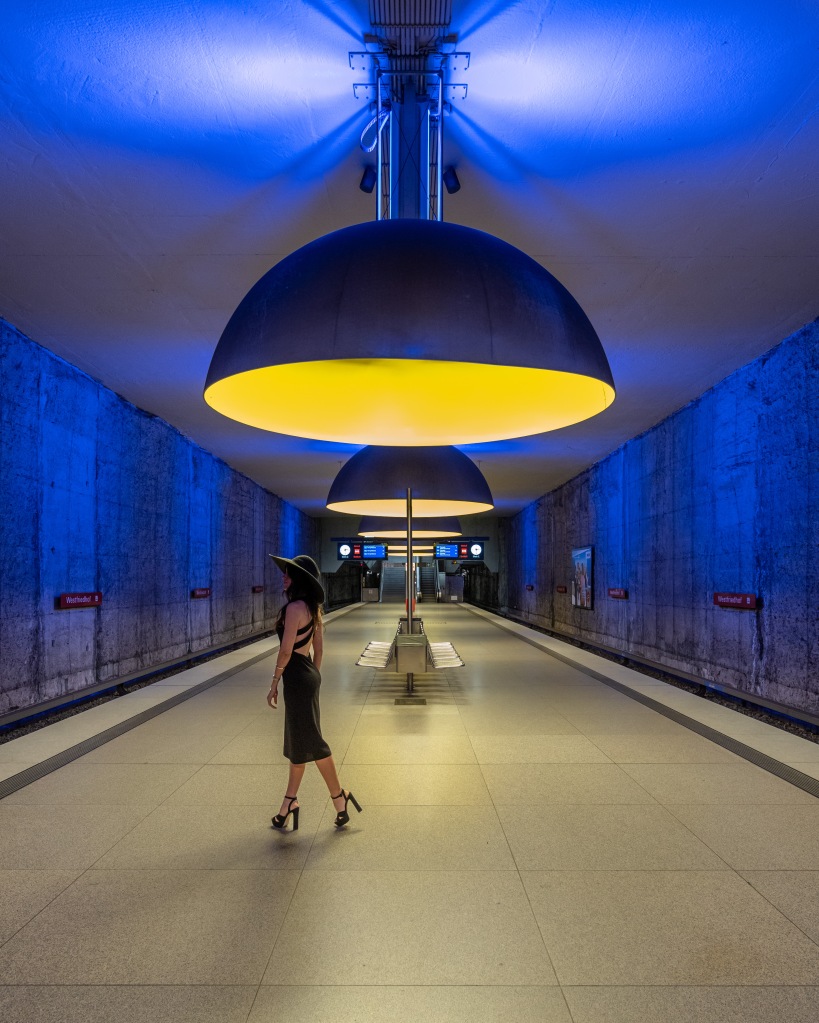
Possibly the most dramatic of Munich’s U-Bahn network of underground railways, Westfriedhof looks more like a surreal painting of Magritte than a station. The Munich U-Bahn started running in 1971, and Rolf Schirmer (a member of the subway planning council) wrote that the designs are meant to ‘make a passenger’s wait more pleasant, something that cannot generally be said of subterranean, mostly artificially lit, spaces.’ The lighting concept was created by the designer Ingo Maurer, who also provided the lighting at the Münchner Freiheit train station, among other structures. There are 11 lamps at this station, which measure about 3.6 metres (12 feet) in diameter. They divide the platform with swaths of blue, red and yellow light. Other stunning stations you shouldn’t miss include Marienplatz Station by Alexander von Branca, Dülferstraße by Ricarda Dietz and Candidplatz by Sabine Koschier. Read more here.
Architect: Westfriedhof by Ingo Maurer
Location: 80992 Munich (Google)
Year: 1998
4. Residenz
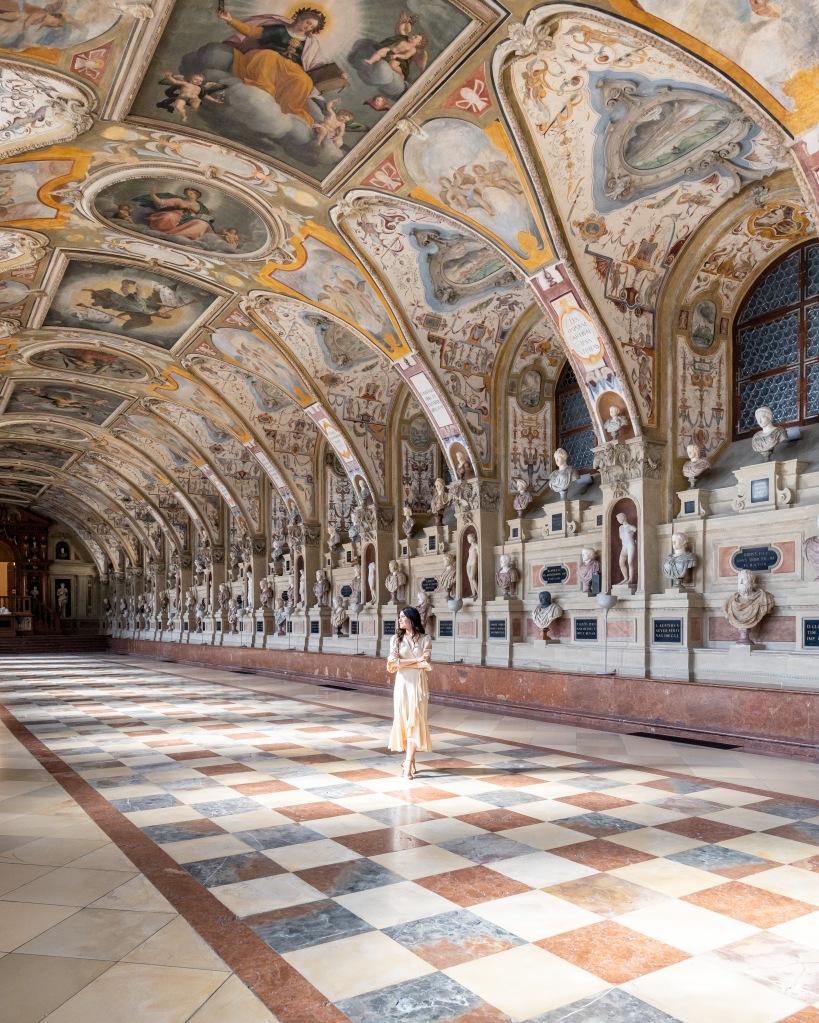
The Munich Residence was originally built as the seat of government and residence of Bavarian dukes, electors and kings from 1508 to 1918. What began in 1385 as a castle in the north-eastern corner of the city (the Neuveste, or new citadel), was transformed by the rulers over the centuries into a magnificent palace. The Antiquarium – the oldest room at Residenz – was built in 1568 to house the ducal Collection of Classical Antiquities and Library. Some of the busts and other sculptures now displayed on the longitudinal walls are from Duke Albrecht V’s collection and the lunettes and the window reveals are decorated with 102 views of towns, markets and palaces in what was then the Duchy of Bavaria. Read more here.
Architect: Leo von Klenze
Location: Residenzstraße 1, 80333 München (Google)
Year: 1568
5. Asamkirche
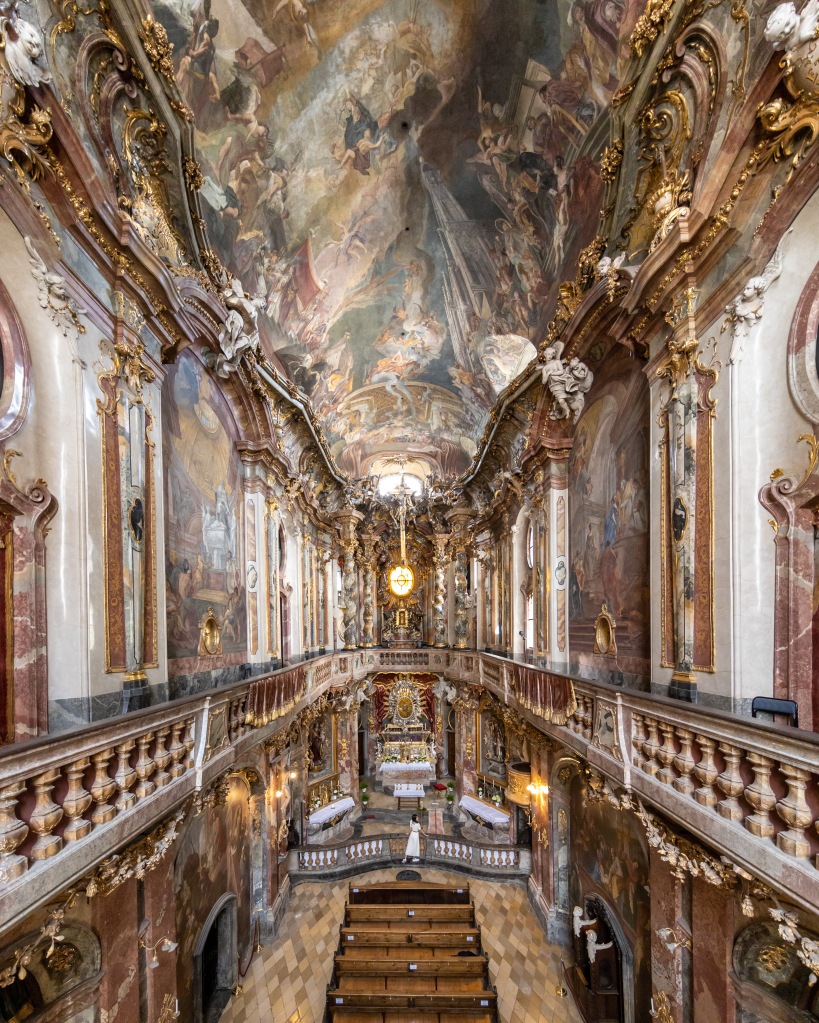
No architect should miss Asamkirche, a Baroque church that was built for private use. Two brothers – Egid Quirin Asam and Cosmas Damian Asam – designed this church in a small plot of land of just 22×8 metres. The church was not commissioned, but built as a private chapel for the greater glory of God and the salvation of the builders. This also allowed the Asam brothers to build in line with their ideas as independent contractors. For example, Egid Quirin Asam could see the altar through a window of his private house next to the church (Asamhaus). The Baroque façade is integrated into the houses of the Sendlingerstraße and swings slightly convex outward. Even more astonishing is the artistry of the two builders, who were able to harmoniously unite in the two-story space architecture, painting, and sculpture. Read more here.
Architect: Sculptor Egid Quirin Asam and painter Cosmas Damian Asam
Location: Sendlinger Str. 32, 80331 München (Google)
Year: 1746
6. Endless Staircase
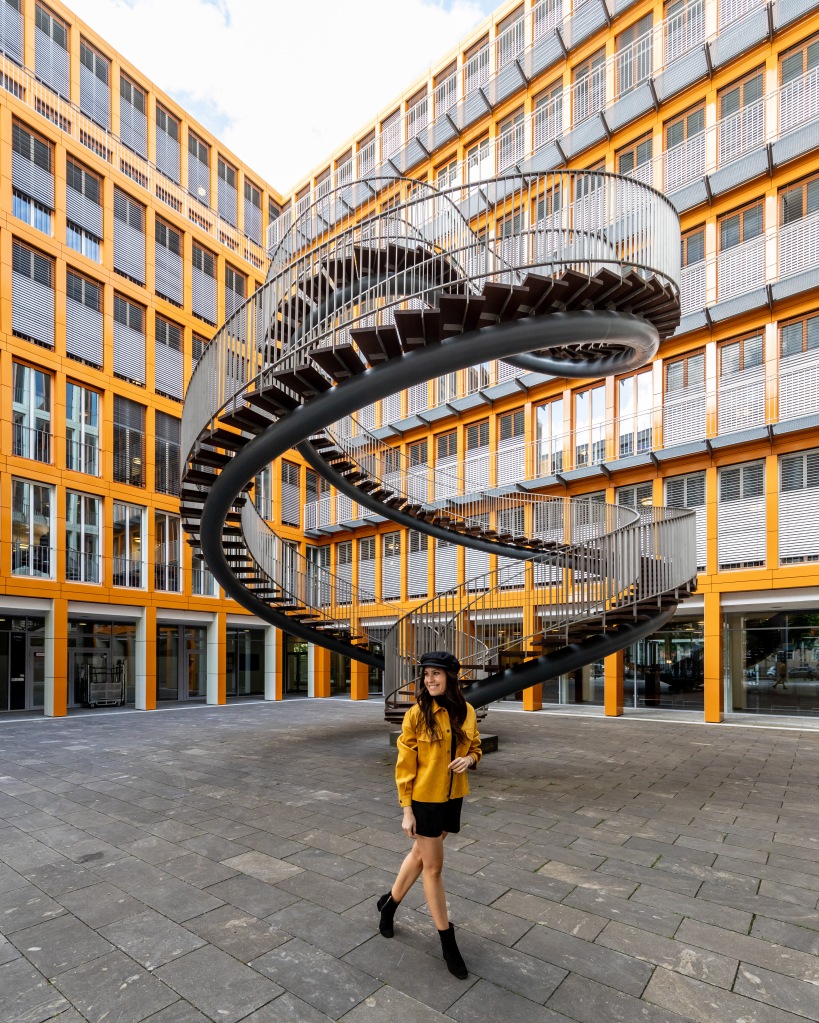
Hidden in the courtyard of an office building in Schwanthalerhöhe, you will find a unique sculpture by Olafur Eliasson. The endless staircase is called Umschreibung which is the German word for ‘circumscription’ or ‘periphrasis’. The sculpture was finished in 2004 inside the headquarters of the KPMG trust. According to the artist, it is supposed to create ‘movement without destination, a space defined by motion rather than walls’. There are no opening hours – it’s a freely accessible courtyard. Read more here.
Architect: Olafur Eliasson
Location: Ganghoferstraße 29A, 80339 München (Google)
Year: 2004
7. Pharao-Haus
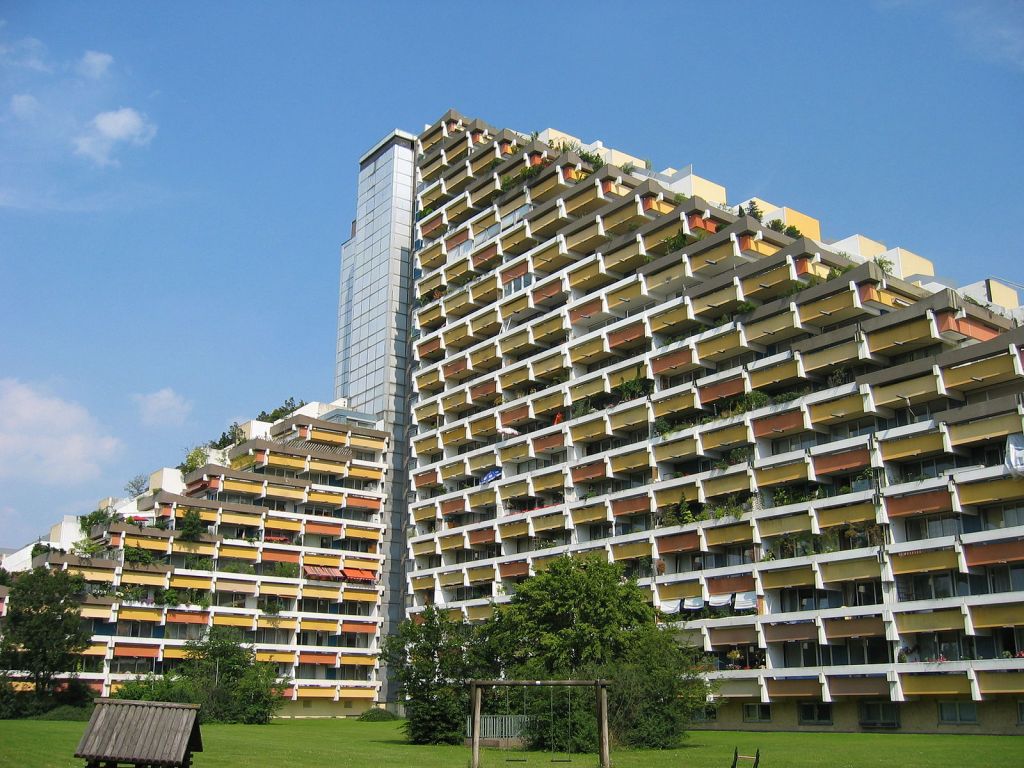
This mighty residential building is popularly known as ‘Pharaoh’ or ‘Pharaoh House’ because of its shape. The pyramid-shaped terraced residential structure consists of three right angled wings containing over 400 flats. The south-west wing has eighteen, the north-east fourteen and the north-west ten floors. An extensive low-rise building with a shopping center and several restaurants extends to the southeast. Unsurprisingly, it has often been the backdrop for TV crime novels. Although the quality of life in the flats, most of which have large balconies and terraces, is very good, the residential complex was a major drug trafficking centre in the 1990s, and still does not have a very good reputation in Munich. Read more here.
Architect: Karl Helmut Bayer
Location: Fritz-Meyer-Weg 55, 81925 München (Google)
Year: 1974
8. Herz-Jesu-Kirche
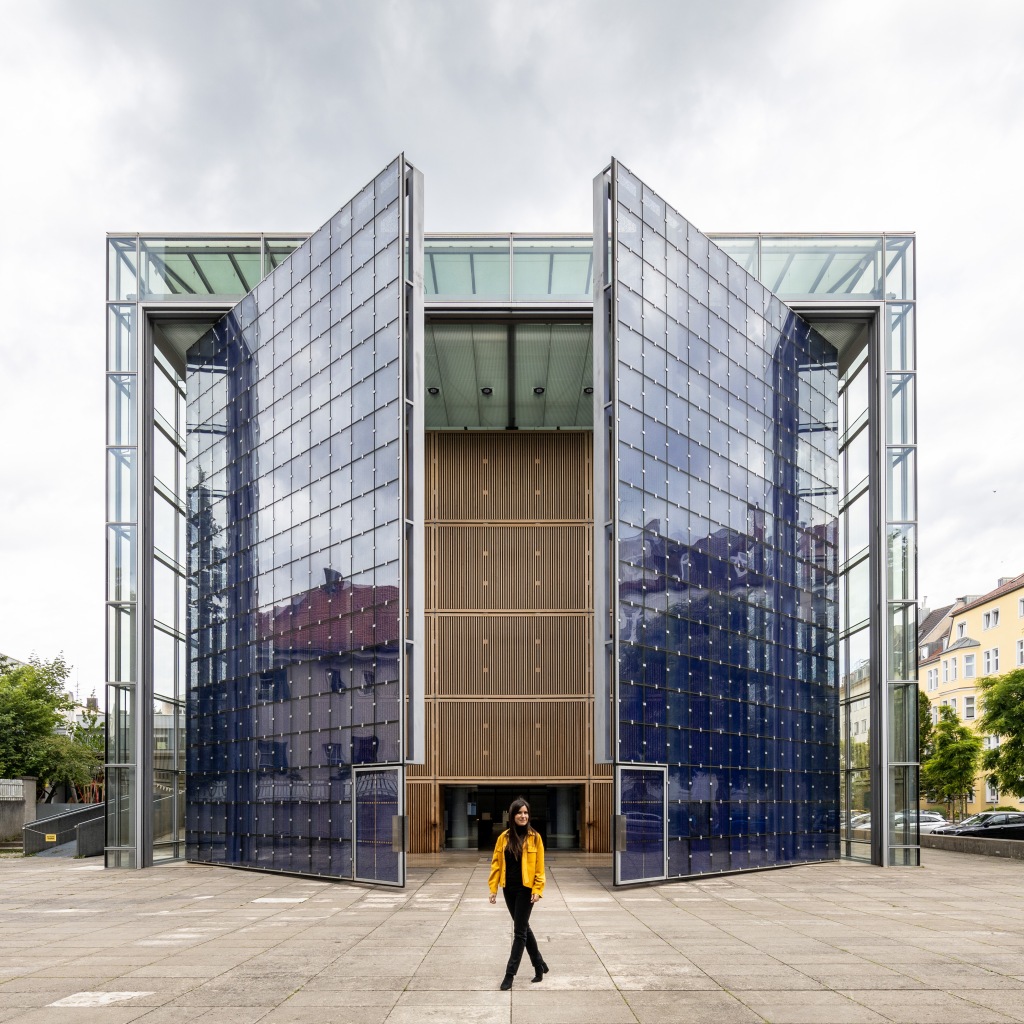
Herz Jesu Kirche (Church of the Sacred Heart) in Munich is one of several contemporary churches that were built in Germany to mark the turn of the millennium. Over the past 15-plus years, this church has become one of the city’s landmarks and a globally recognised icon of ecclesiastical architecture. The boundaries between interior and exterior are not definitively prescribed, but rather chosen in response to the situation at hand. The church presents itself as a box inside a box– the interior box clad in vertical maple louvers and the exterior box encased in glass. Nevertheless, the real special feature is the front, which is entirely opened hydraulically. The portal measures 14 metres (46 feet) high, 18 metres (59 feet) wide, and weighs 50 tons, making it among the largest in the world. Read more here.
Architect: Allmann Sattler Wappner
Location: Lachnerstraße 8, 80639 München (Google)
Year: 2000
9. Munich Olympic Stadium
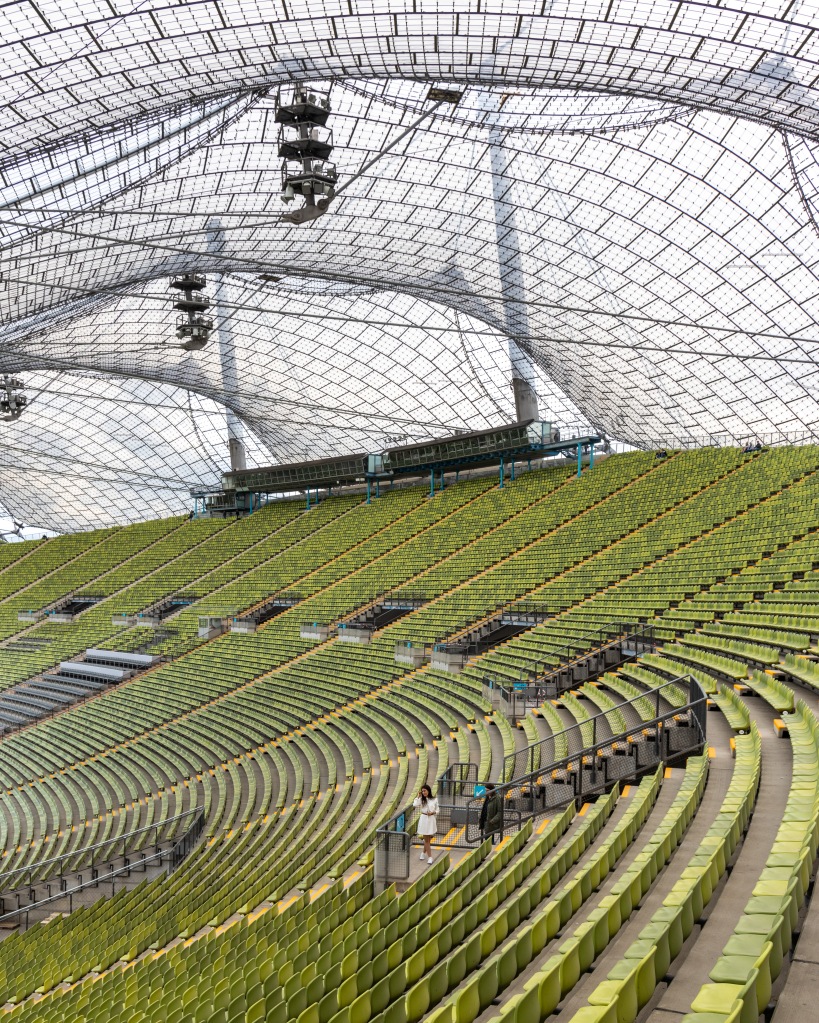
The Munich Olympic Park is situated in the area of the city known as ‘Oberwiesenfeld’ (‘High Meadow Country’ or ‘Mountain of Debris’) because of its use as a military ground during the Second World War and its subsequent reduction to a mountain of debris. The architects Günther Behnisch and Frei Otto were in charge of designing and building the stadium that would host the Olympic Games in Munich 1972, the second time Germany was host. They raised a lightweight structure where tensions are nullified by a system of supports and cables, pioneering the use of mathematical calculations based on computational procedures to determine the shape and behavior of the surface of the cover. Otto and Behnisch voltage conceptualised a structure that continuously flows along the site mimicking the draping and the rhythmic elevations of the Swiss Alps. The junction between the various cables that make up the structural mesh is materialised by a knot of steel casting with a system using bolted anchors and tension. Read more here.
Architect: Günther Behnisch and Frei Otto
Location: Olympiapark München, Spiridon-Louis-Ring 25, 80809 München (Google)
Year: 1972
10. OlyDorf Bungalows
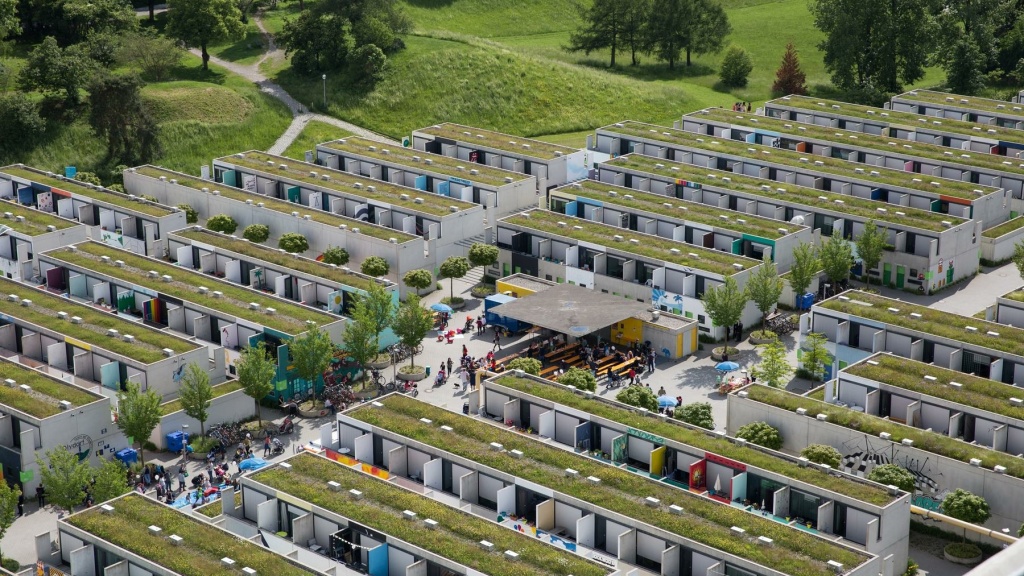
Since the 1972 Olympics, students have been living in the tower and bungalows of the former women’s olympic village. From spring 2007, the bungalows were partially demolished over a period of three years and rebuilt monument-appropriate, since renovating the existing buildings would not have been cheaper. Of the old bungalows, 12 were originally preserved and renovated and in the autumn of 2009 students moved back in. The Studentenwerk München commissioned the Munich architects Günther Eckert and Werner Wirsing with the construction of a student residency. Each student was also allowed to paint their house however they like when they moved in and the Studentenwerk actually pays for the paint. Olydorf (shortened version of its old name ‘Olympisches Dorf’ – ‘olympic village’), is full of brightly-coloured, comic-book-style houses that are well worth a visit. Read more here.
Architect: Günther Eckert and Werner Wirsing
Location: Connollystraße 3, 80809 München (Google)
Year: 2009
11. BMW Welt
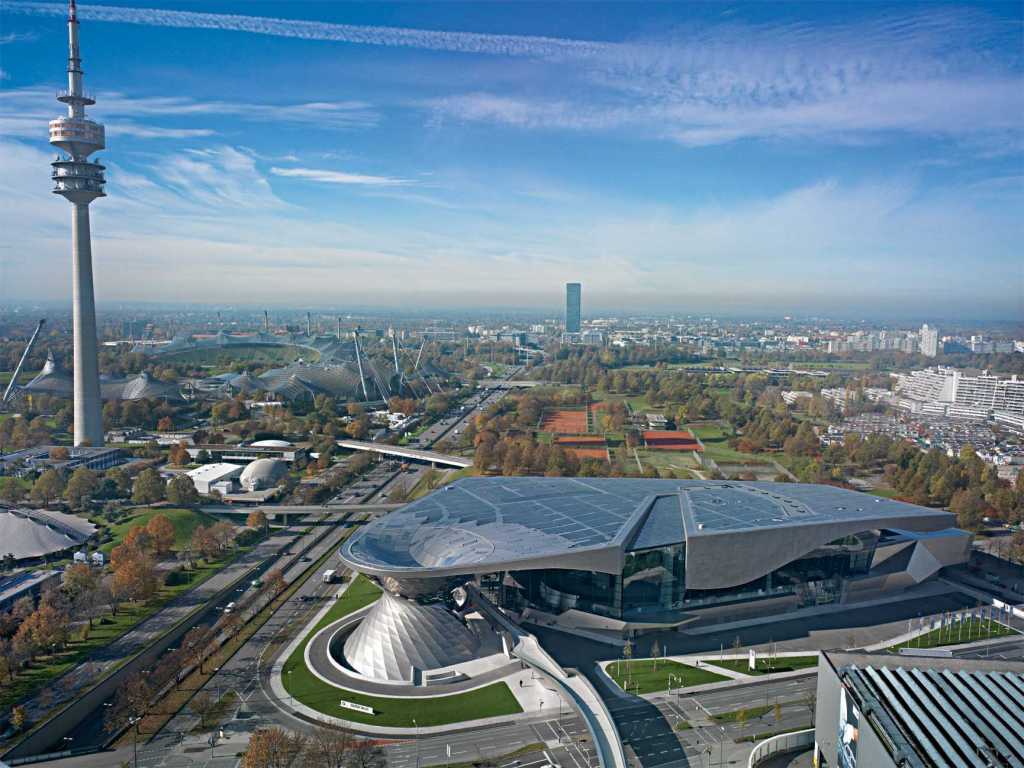
The BMW Welt is a combined exhibition, delivery, adventure museum, and event venue located in Munich’s district Am Riesenfeld, next to the Olympic Park, in the immediate vicinity of the BMW Headquarters and factory. The key task of the new BMW Welt is to deliver cars. In the Premiere section, everything is geared towards enhancing the experience of delivery. Because of the exhaust gases that this involves, special considerations and calculations had to be made for ventilation since the Premiere is open to the Hall, the major space in this world of experience. Beyond merely fine-tuning the volume of air intake and outflow currents, it was necessary to directly extract the exhaust fumes and pump-in fresh air. Planning here was based on an assumed turnover of 40 cars per hour or 250 cars per day. Although this might be the main BMW attraction nowadays, don’t miss the nearby BMW Tower (global corporate headquarters of BMW since 1973), the museum and the lesser known BMW Parkhaus FIZ, also a popular spot on Instagram. Read more here.
Architect: Coop Himmelb(l)au
Location: Am Olympiapark 1, 80809 München (Google)
Year: 2009
12. Allianz Arena
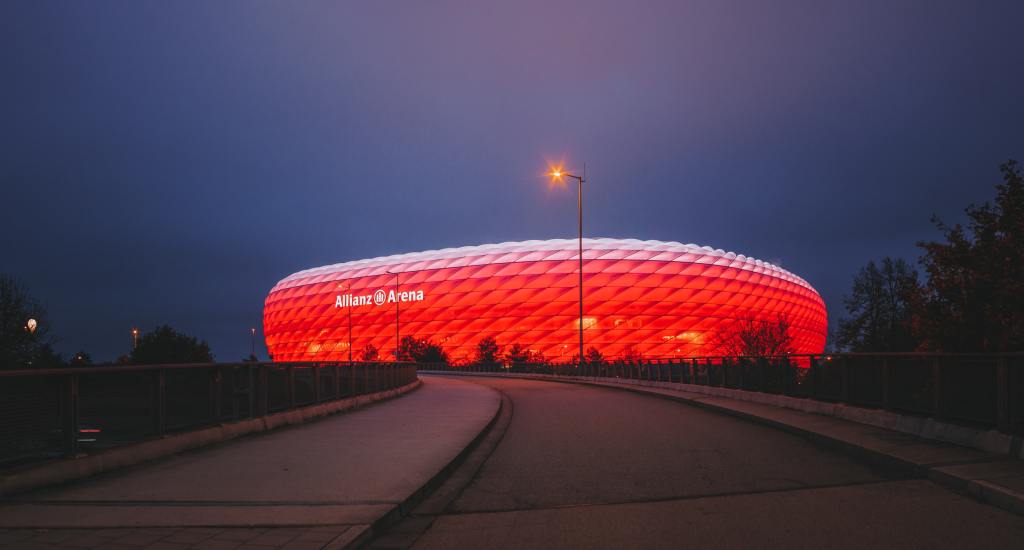
This ground-breaking home for two football clubs, Bayern Munich and TSV 1860, was also the venue for the opening game and one semifinal of the 2006 World Cup. The stadium’s unusual form and skin of translucent ETFE pillows make it instantly recognisable. The effect is enhanced at night by special lighting that allows the colour of the façade to change to match the colours of the home team playing that night. Its façade consists of the largest membrane shell in the world. It is about 35 metres high and has an outside surface area of 29,000 m². It is also one of the most stunning examples of Biomorphic architecture. Read more here.
Architect: Herzog & de Meuron
Location: Werner-Heisenberg-Allee 25, 80939 München (Google)
Year: 2005
13. Bayerische Staatskanzlei
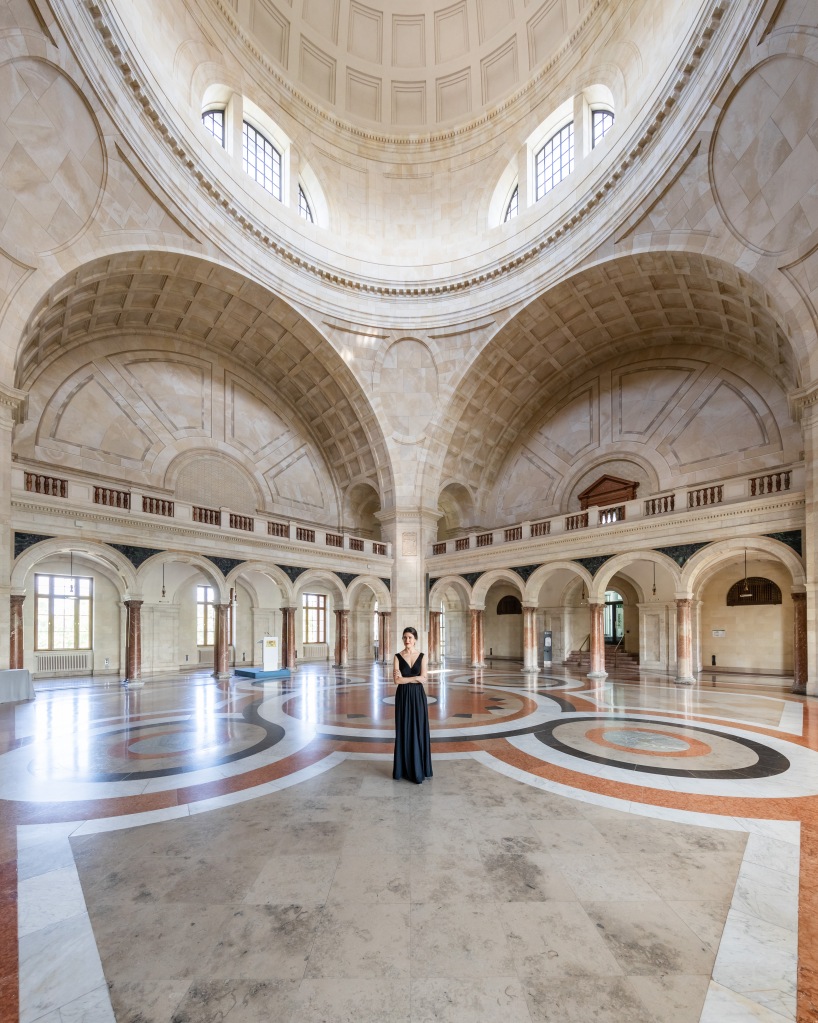
One surprisingly public space that almost remains a private secret is the Bayerische Staatskanzlei – The Bavarian State Chancellery. It was erected from 1989 to 1993 around the central dome of the former Bavarian Army Museum, which had been built in 1905 at the site of the Hofgartenkaserne barracks and was demolished in World War II. The museum then was moved to the New Castle in Ingolstadt. With reference to Leo von Klenze’s neighbouring Festsaalbau of the Munich Residenz, the new building of the Bavarian Army Museum was also influenced by the Italian High Renaissance architecture, but shows the monumentalisation of the late Historicism. The remnants of some Renaissance arcades of the Hofgarten in the north were integrated to the structure and the original space underneath the dome became the central space of the building. Read more here.
Architect: Ludwig Mellinger (1905) and Diethard J. Siegert & Reto Gansser (1993)
Location: Franz-Josef-Strauß-Ring 1, 80539 München (Google)
Year: 1993
14. Alte Pinakothek
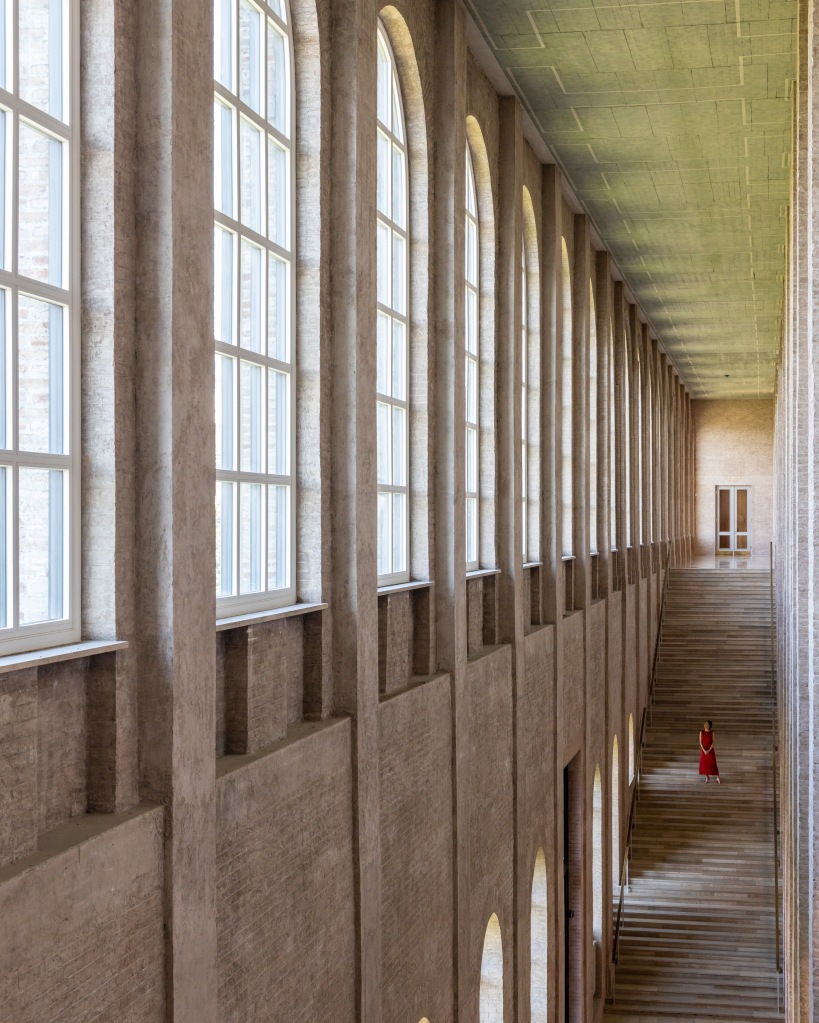
The picture-perfect staircases at the Alte Pinakothek are a common depiction in Munich postcards. But their story goes beyond the aesthetics. King Ludwig I of Bavaria was a passionate art collector. Around 1820, he decided to make his treasures accessible to the public and commissioned his court architect Leo von Klenze to design a worthy art gallery. The Alte Pinakothek was the largest museum in the world at the time of its completion; structurally and conceptually well-advanced through the convenient accommodation of skylights for the galleries – something rare at the time. The museum building was severely damaged by bombing in World War II but was reconstructed and reopened again to the public in 1957. Director Ernst Buckner oversaw the rebuilding project, ensuring that the building remained true to its original architecture. The ornate, pre-war interior, including the large loggia facing the south façade in the upper floor, was not restored. Old and new can best be appreciated from the outside. Read more here.
Architect: Leo von Klenze and Hans Döllgast
Location: Barer Str. 27, 80333 München (Google)
Year: 1836
15. Müller’sches Volksbad (Hallenbad)
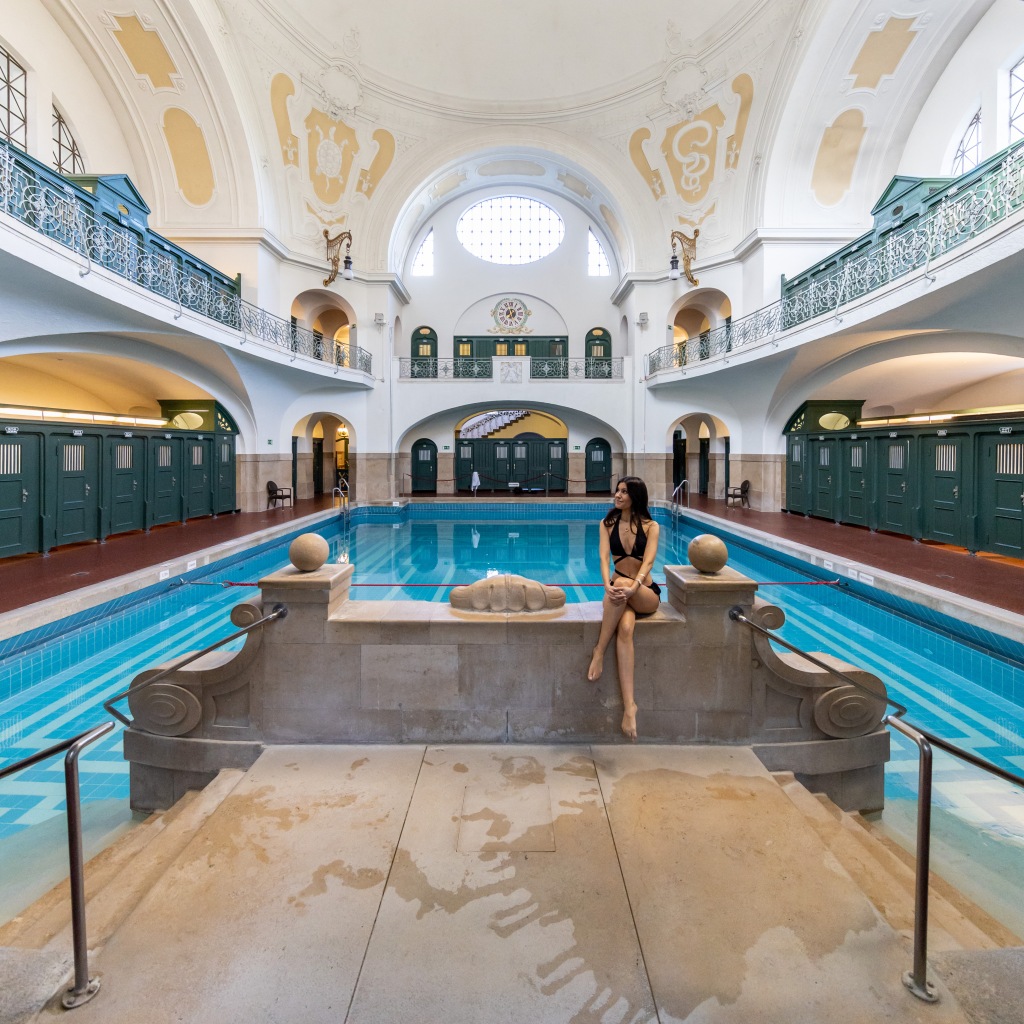
The Müllersches Volksbad was completed in 1901. At the time of its completion, the Neo-Baroque Art Nouveau building was the largest and most expensive swimming pool in the world – and the city’s first public indoor pool. The construction goes back to a donation by engineer Karl Müller to the city of Munich, combined with the requirement to build a bath for the ‘poor people’. With its architecture and interior design, the bath became one of the most beautiful bathhouses in Europe. Carl Hocheder took inspiration in the design of a variety of models: Roman thermal baths as well as sacred buildings, hammams and mosques, all held together by contemporary Art Nouveau elements. The rich Baroque decorations inside include wide staircases leading down into the pools, murals with marine motifs, stucco work, a bronze statue in the main pool, ornate iron railings and wooden parapets, as well as intricately designed clocks. Read more here.
Architect: Carl Hocheder
Location: Rosenheimer Str. 1, 81667 München (Google)
Year: 1901
16. Sudetendeutsches Museum
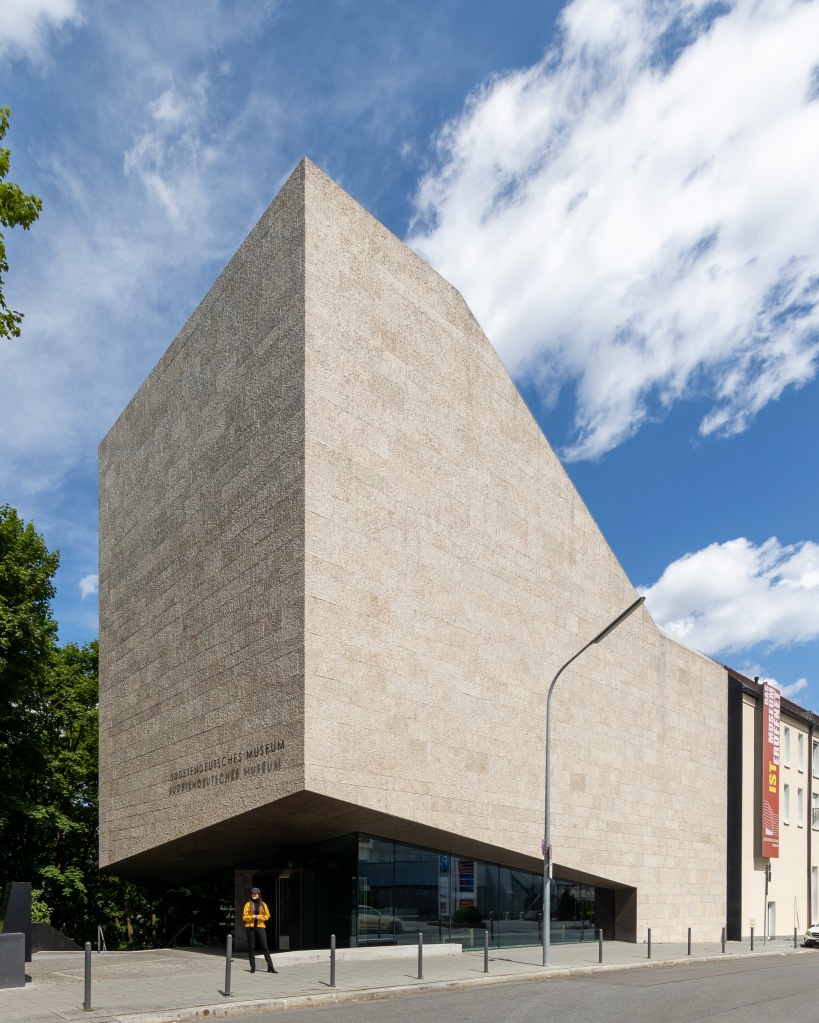
This Neo-Brutalist building opened just before the pandemic, meaning it’s one of Munich’s newest architecture secrets. When viewed from the street, the museum follows the structure of the existing buildings and picks up their eaves and ridge heights. In accordance with the terrain, the building develops into a looser structure as it stretches down the hillside, and it opens up towards the green hillside with a five-story incision that spans the entire height of the building. The new build is cladded with natural stones and mostly appears enclosed and monolithic. The natural stones on the vertical surfaces have been treated by hand and have a rough finish. The Sudeten German Museum is the central museum of the German-speaking population in the Bohemian lands. The permanent exhibition spans more than 1,100 years of the history of the region, its art and its culture and its well-worth a visit. Read more here.
Architect: pmp architekten
Location: Hochstraße 10, 81669 München (Google)
Year: 2020
17. Ohel Jakob Synagogue
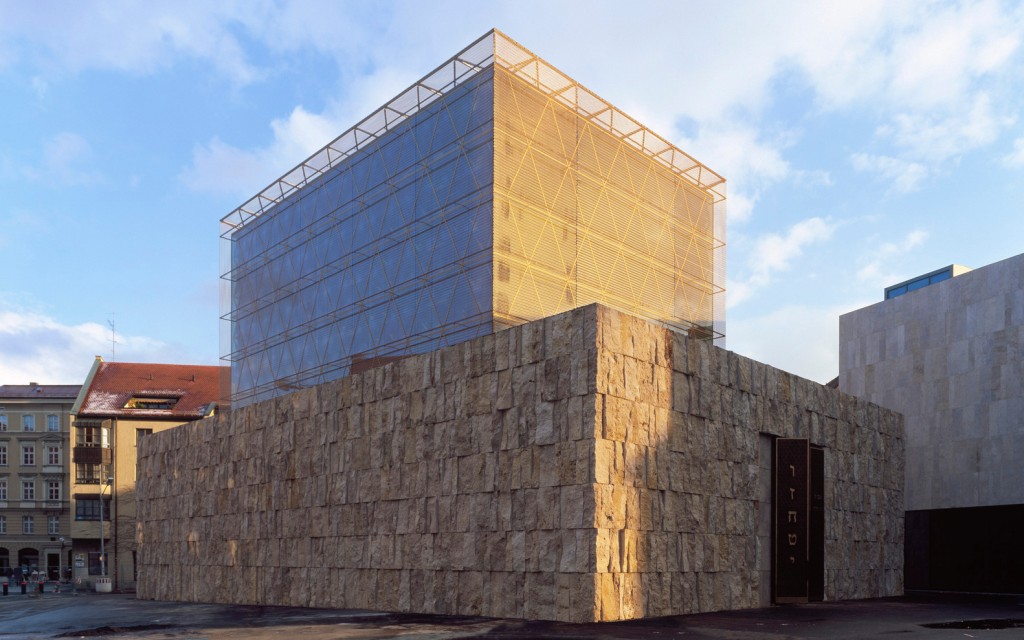
The new Ohel Jakob Synagogue (from the Hebrew for ‘Jacob’s Tent’) was officially inaugurated at the Jüdisches Zentrum in November 2006. It meant that, finally, Munich’s Jewish community had a main synagogue once again following the destruction during 1938’s Pogromnacht (also known as Kristallnacht, the Night of Broken Glass) of the former Ohel Jakob Synagogue in Herzog-Rudolf-Straße. Munich’s Jewish community defines itself as orthodox, and is the second largest in Germany, numbering some 9,500 adherents. The synagogue consists of two cubes, one on top of the other: The mighty stone base is intended to resemble the Wailing Wall in Jerusalem. Atop it sits a glass cube featuring interlaced Stars of David, encased in a bronze metal veil. The glass structure represents a tent, symbolising the 40 years the Jews spent wandering the Sinai desert. On the portal of the synagogue are the first ten letters of the Hebrew alphabet, which are reminiscent of the Ten Commandments. Visitors can access the interior of the building via the underground ‘Gang der Erinnerung’ (‘Corridor of Memory’), which connects the synagogue with the community centre. The walls of the 32-metre passage bear the names of 4,500 Munich Jews who were murdered under the Nazi regime. Read more here.
Architect: Rena Wandel-Hoefer and Wolfgang Lorch
Location: Sankt-Jakobs-Platz 18, 80331 München (Google)
Year: 2006
18. Pagodenburg
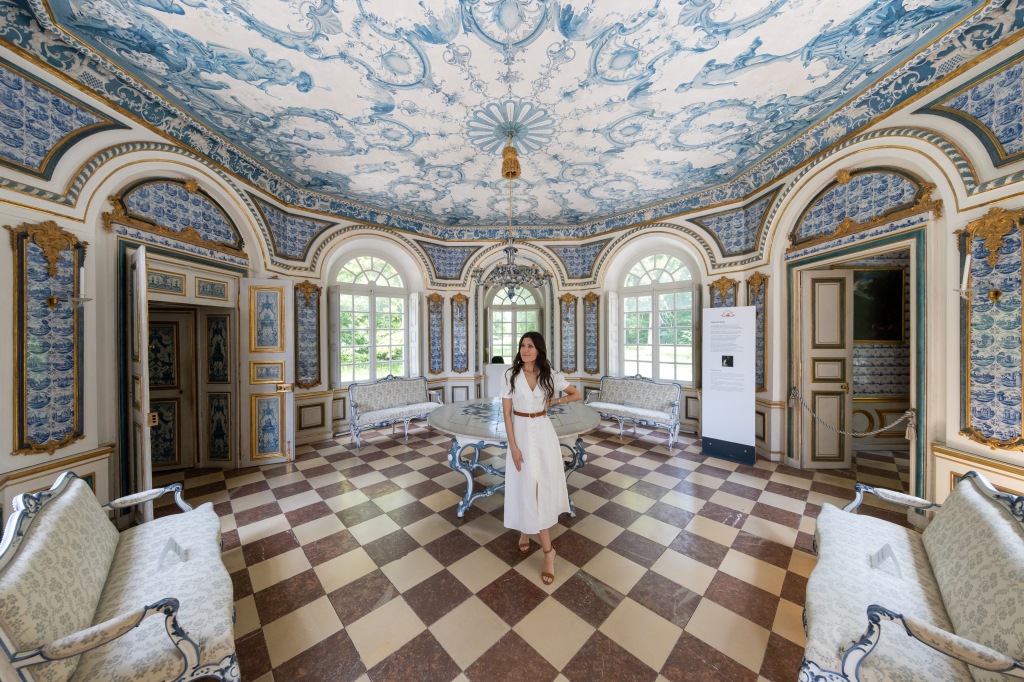
The Pagodenburg is a prime example of eighteenth-century chinoiserie which was very much in vogue at the time. This small structure was built between 1716 and 1719 by Joseph Effner to a commission from Elector Max Emanuel. Sited north of the main canal, it respects the original plan of the park. To the south of the little palace lies a garden parterre, and to the north a green where the ‘Mailspiel’, a game similar to golf, was played. On the ground floor the colours blue and white predominate which, together with the exotic elements of the partly ornamental, partly figural ceiling painting and the Dutch tiles, allude to China and porcelain production. The upper floor accommodates very small but cleverly designed rooms. The Chinese Drawing Room with Chinese wallpaper and black-grounded lacquer painting looks exotic thanks to its colour scheme. The Chinese Cabinet , by contrast, has red-based lacquerwork. Despite its European Regency-style decoration, the Boudoir also has an exotic air on account of its bizarre shape. The rooms were furnished by Johann Anton Gumpp and Johann Adam Pichler. Read more here.
Architect: Joseph Effner
Location: Schloß Nymphenburg 1, 80638 München (Google)
Year: 1719
19. Heavy Riders Theatre
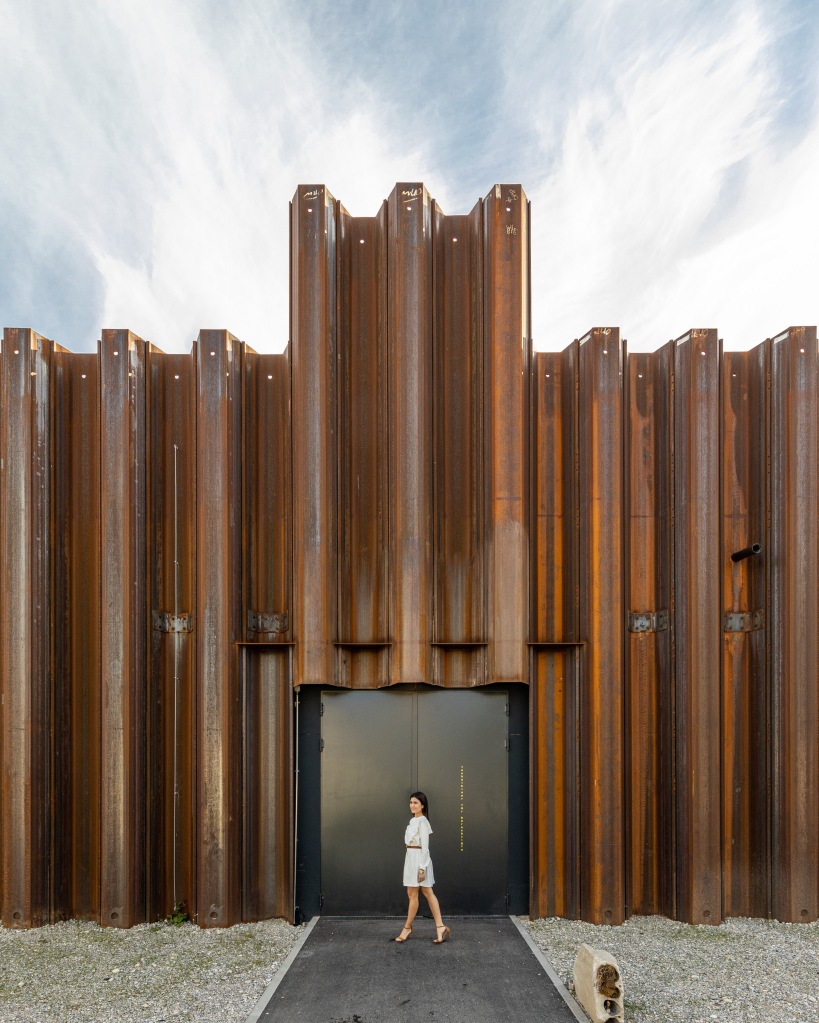
In the creative quarter of Munich – a transitional area on the site of the previous Luitpold barracks – a new cultural building of a special type has arisen. The architect firm Mahlknecht Herrle created an original, temporary events location for dance, theatre and music that attracts attention with its extremely striking facade in classic sheet piling. The new building replaces the previous venue for three free cultural institutions that was in severe need of renovation. For the artistic cooperation, a building was needed that could be implemented in the shortest possible time and easily taken down again after its period of use. The sheet piling used, which is normally set into the ground to secure building excavations, can simply be taken out again and transported to a new location to be reused when the building is dismantled. Its raw, untreated, rusty iron surface with the typical corrugated, building-site look is ideally suited to the provisional character of the creative quarter, which is characterised by workshops and studios, alternative art and lots of individual initiatives of local promoters of culture. Read more here.
Architect: Mahlknecht Herrle
Location: Dachauer Str. 114, 80636 München (Google)
Year: 2021
20. WERK12
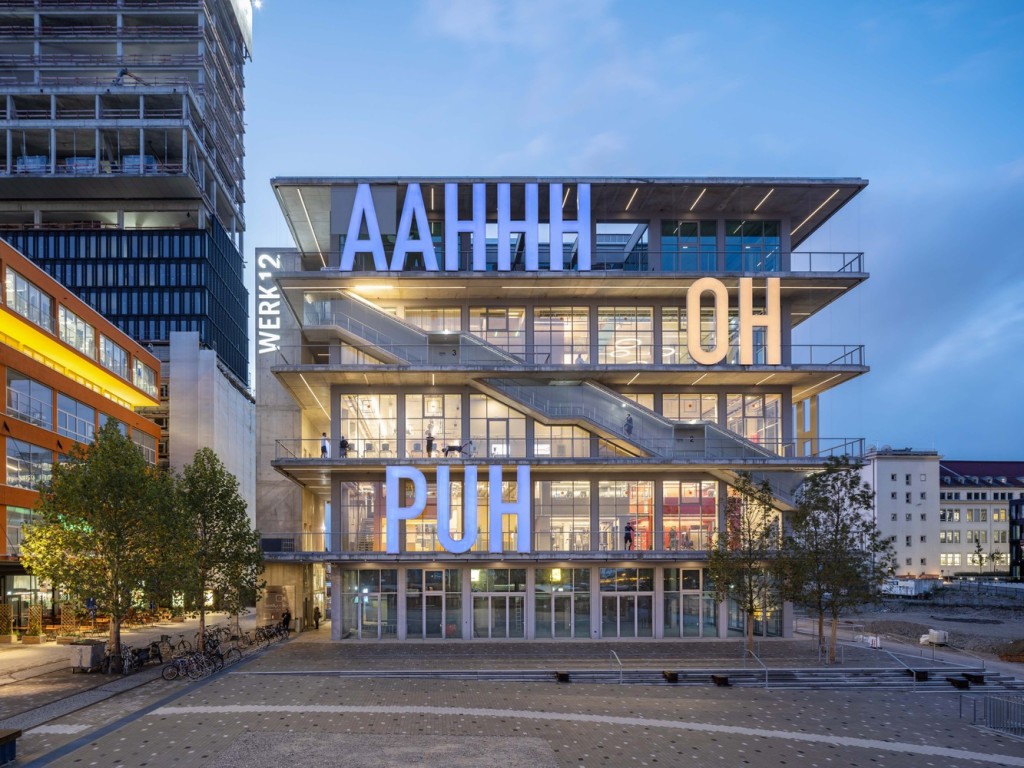
Forming the nucleus of the Werksviertel-Mitte district (an urban regeneration plan on a former industrial site), WERK12 stands out with its bold and expressive art façade featuring five-metre-tall verbal expressions found in German comics. The design of WERK12 combines a simple form, honest materials, and transparent façades. Users can move around the building in multiple ways: the design’s external circulation core on the building’s northeastern side is supplemented by 3.25-metre-wide terraces that surround each floor of the building. These are connected by external staircases curling around the building to connect these generous open spaces – a playful reference to one of MVRDV’s most famous early projects: the Dutch Pavilion at the Expo2000 in Hanover. This public route up the building blurs the distinction between interior and exterior, placing the interior spaces in conversation with exterior balconies. These are additionally finished in the same material as the ground-level sidewalks to emphasise their status as part of the public area of the building. Read more here.
Architect: MVRDV + N-V-O Architekten
Location: Speicherstraße 20, 81671 München (Google)
Year: 2019
21. Pinakothek der Moderne
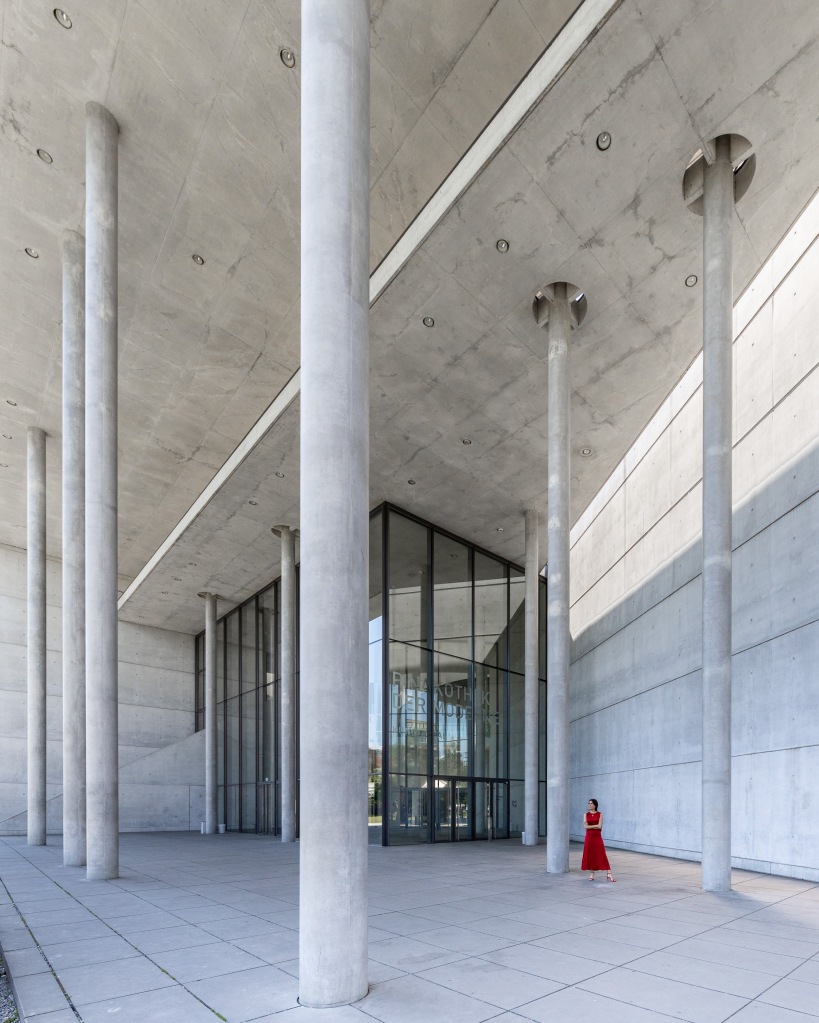
The Pinakothek der Moderne, built by controversial architect Stephan Braunfels, is one of the largest museums for modern and contemporary art, architecture and design in Europe. Four completely independent collections present themselves under one roof: the Architekturmuseum of the Technical University of Munich, the Neue Sammlung – The Design Museum Munich, the Sammlung Moderne Kunst and the Staatliche Graphische Sammlung. The first floor, containing the art collection, has ample natural light from above, augmented by computer-controlled lamps, designed to keep a consistent, nearly shadowless illumination against the gray floors and white walls. The building took a decade to finish because of bureaucratic objections to design and cost, which were ultimately bridged by private initiative and financing. Read more here.
Architect: Stephan Braunfels
Location: Barer Str. 40, 80333 München (Google)
Year: 2002
22. Glyptothek
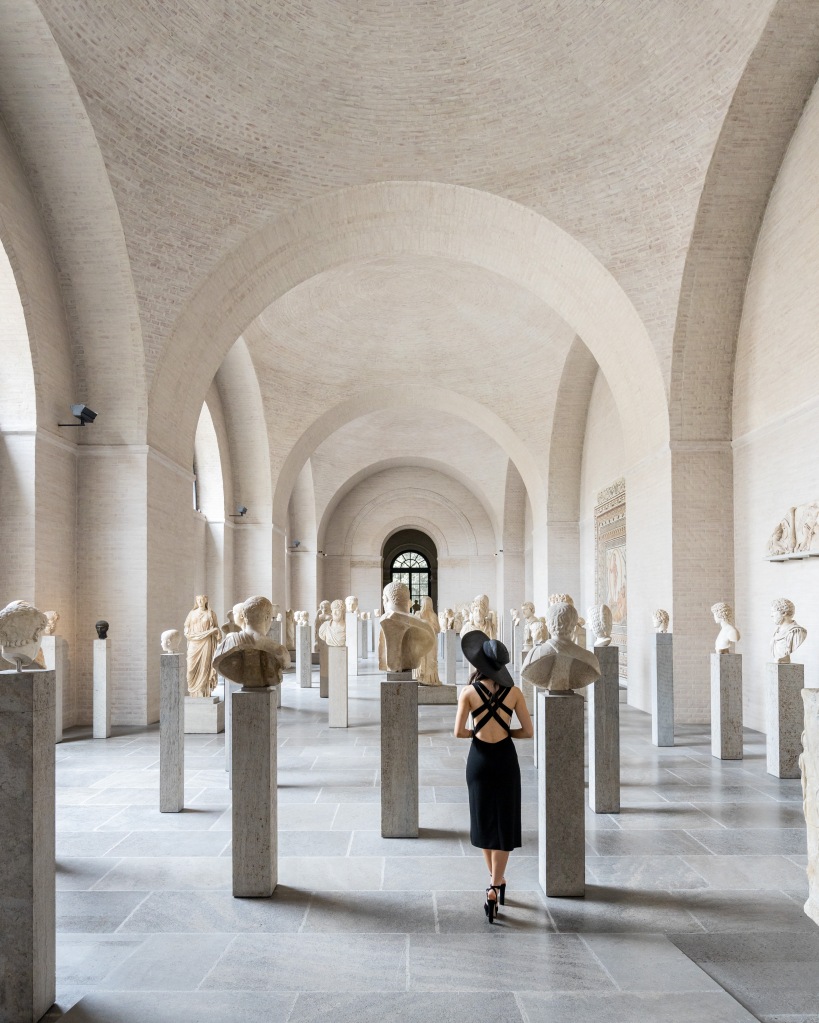
The poetic Glyptothek is another must-see in the Kunstareal, Munich’s gallery and museum quarter. The building, commissioned by the crown prince (later king) Ludwig of Bavaria and designed in the Neoclassical style by Leo von Klenze, was erected in 1830. Most of the core collection was acquired by Ludwig. It comprises Greek sculptures from the Archaic, Classical, and Hellenistic periods as well as Roman sculptures from the Imperial era. Notable pieces include the Barberini Faun (c. 220 BCE) and the pediment sculptures (c. 500 BCE) from the Temple of Aphaia in Aegina, Greece. The Glyptothek was damaged during World War II, but it was restored and reopened in 1972. It again underwent extensive renovations between 2018 and 2021. Read more here.
Architect: Leo von Klenze
Location: Königsplatz 3, 80333 München (Google)
Year: 1830
23. Textilmacher
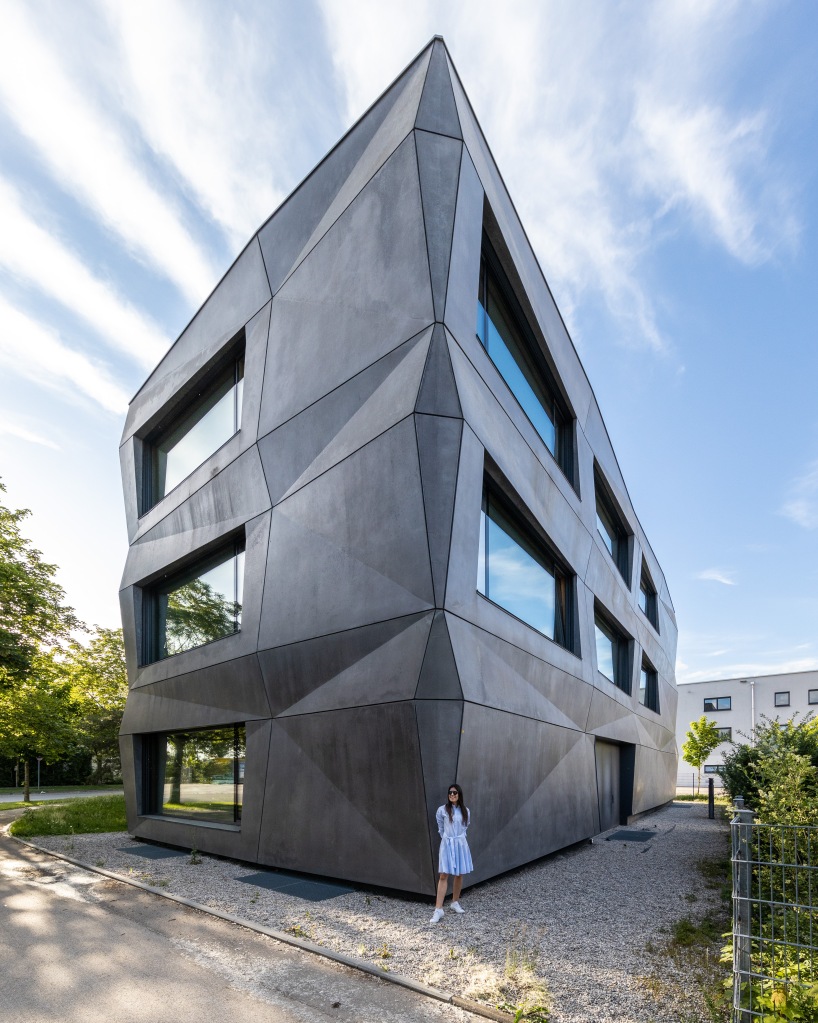
Probably the most random location of the list is this concrete jewel of a building. The structure completed in 2016 works as a production and office space for a company from the textile industry. The defining element: the folded facade, whose geometry creates a characteristic interplay of light and shadow. The smooth, matt-shiny surfaces of the coloured concrete always react anew to the time of day and year, the weather and the incidence of light. The facade is sometimes modelled more strongly by the light, then, less so again. Due to the exposed location on a corner plot, this special feature can be experienced from several sides, and the sequence and precise joining of the elements can also be understood. The restriction to a few, high-quality and surface-true materials continues inside. The floor is made of a polished, seamless screed, the window profiles are made of larch wood, the door and window handles are made of highly polished stainless steel with concealed hinges. Read more here.
Architect: Tillich Architektur
Location: Lindberghstraße 7, 80939 München (Google)
Year: 2016
[BONUS] – Sankt Josef Church
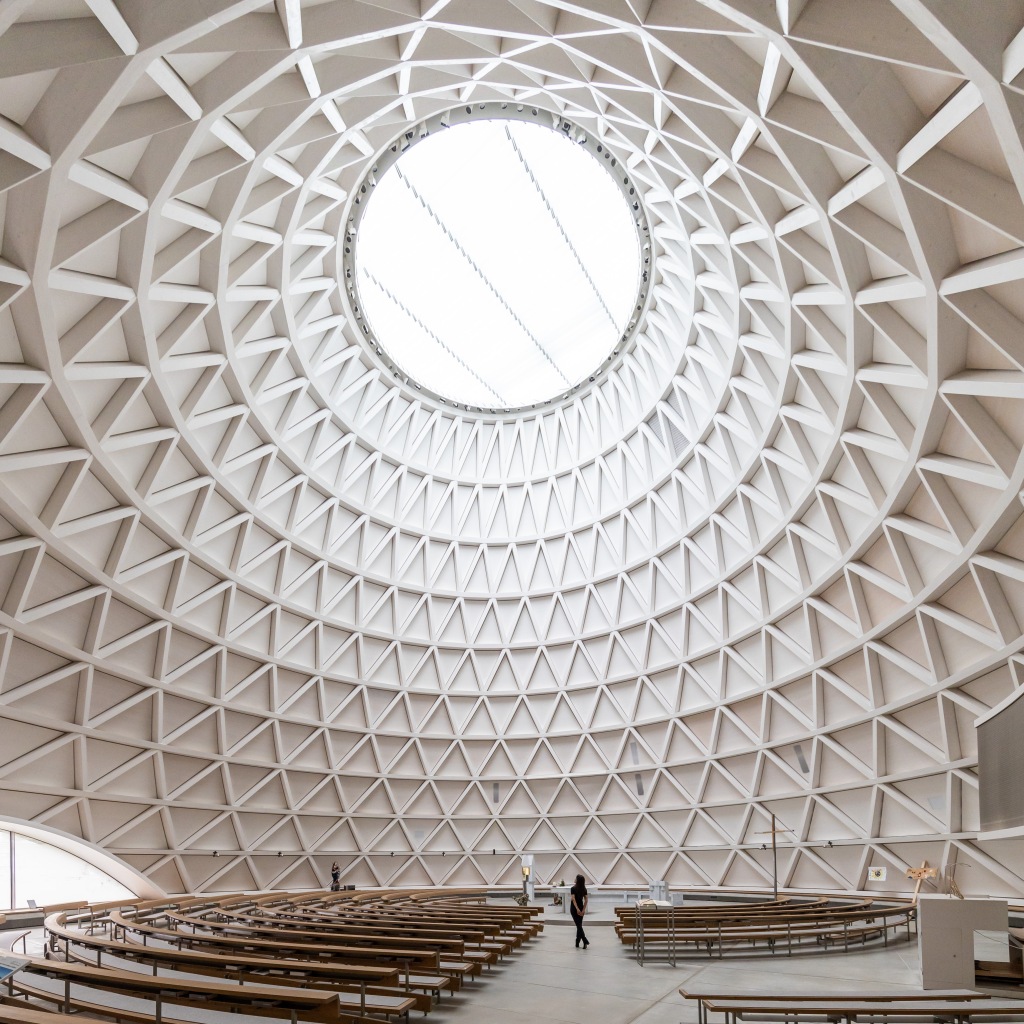
Though technically not in Munich, Sankt Josef Church is near enough for you to visit. This Catholic church in Holzkirchen, Upper Bavaria, was completed in 2018 to a design by Munich architect Eberhard Wimmer. Declining numbers at services, churches closing because maintenance is too expensive or a scandal has shaken the media, there are many reasons why church communities are reluctant to invest. Most projects are refurbishments and restorations. The new construction of the Sankt Joseph church in Holzkirchen is therefore remarkable in several respects. In the Archdiocese of Munich and Freising it is the first newly consecrated church in ten years. And Sankt Josef was built entirely of wood. The new church center consists of a mighty round church with a small chapel and the church tower of the previous building. The church and chapel were designed as oval cones of different sizes, tilted slightly backwards. The elliptical floor plan with 32 different axes and angular deviations posed a number of challenges for the planners and designers, as no standardised formwork and sound gauges could be used. Both cones are capped, the larger at 22 meters, the smaller at eleven meters. Viewed in cross section, they take up the curves of the Alpine panorama on the one hand and at the same time convey an archaic-organic impression. Read more here.
Architect: Eberhard Wimmer
Location: Pfarrweg 4, 83607 Holzkirchen (Google)
Year: 2018
Check these and other amazing locations on the map below or download my free Munich Architecture Guide (PDF):
Pingback: Biomorphic Architecture: 10 Stunning Examples | Virginia Duran
Ich war gerade in München, mein Sohn lebt dort.
Danke für die Zusammenfassung 🤩
LikeLiked by 1 person
Ahhh das ist erstaunlich. Hat dir die Stadt dieses Mal gefallen? Seit wann lebt dein Sohn dort?
LikeLiked by 1 person
Liebe Virginia,
Mein Sohn lebt seit drei Jahren in München, er hat Wohnung und Arbeit dort und heiratet nächstes Jahr in München.
Ich denke nicht, dass er wieder nach Berlin zurück kommen wird.
Mir wird München immer vertrauter, jedoch auf andere Art als als Touristin. Deine Gebäudeliste nehmen wir zum Anlass, München aus dieser Perspektive kennenzulernen.
Einen schönen Tag von Susanne
LikeLiked by 1 person
Liebe Susanne,
Das ist toll! Herzlichen Glückwunsch zur Hochzeit. Ich bin mir sicher, dass Sie eine schöne Zeremonie in München haben werden. Ahhh Berlin und München, die Städte sind nicht zu vergleichen. Ich liebe Berlin so sehr, seine Energie ist etwas ganz Besonderes. München ist ruhiger und schöner. Ich hoffe, deine nächste Reise enthält etwas von dieser Liste 🙂
Schönen Tag von Virginia
LikeLike
Das finde ich auch, Virginia, Berlin und München sind so unterschiedlich wie nur Städte sein können. Ich mag beide Städte, die Ruhe Münchens ist wohltuend nach dem quirligen Berlin.
Einen schönen Tag von Susanne
LikeLiked by 1 person
Dir auch ein schönes Wochenende 🙂
LikeLiked by 1 person
Incredible combo of new and old. Definitely high on my list for whenever I make it across the pond next. Hope everything is great for you!
LikeLiked by 1 person
Hi Chuck, how are you? It’s been a long time. Munich has become one of my favourite cities in Germany, glad you appreciated it too 🙂
LikeLike
Amazing lists and beautiful photos!
Do you have any recommendations on ideal time and weekday/weekend to get such a clear background?
LikeLiked by 1 person
Thank you 🙂 You mean for taking photos? I’d say the summer months: from May onwards it’s very good. Have you been to Germany before?
LikeLiked by 1 person
Thank you! closest I’ve ever been was Switzerland around September.
Already got a wish list of restaurant in Munich so these spots would pair very well when I got a chance to visit 😀
LikeLiked by 2 people
Yeah then it’ll be similar weather to Switzerland. Food & architecture sounds delightful. The map at the end of the article includes some additional restaurants and bars, I’m sure you’ve got some of them already.
LikeLiked by 1 person
Cool! Thanks again for such an amazing guide.
LikeLiked by 2 people
You are welcome ☺️
LikeLiked by 1 person
They are all stunning! Great work 👏
LikeLiked by 1 person
Thanks Clara! What’s your favourite?
LikeLike
Hard to pick just one! I find 10-OlyDorf Bungalows, 13-Bayerische Staatskanzlei and 18-Pagodenburg very interesting ❤️
LikeLiked by 1 person
Great choices! Thanks for stopping by and adding your thoughts 🙌🏼
LikeLike
Amazing archetict , exceptional beauty.
LikeLiked by 1 person
Many thanks Jalal! Any favourites in the list?
LikeLike
Hard to chose , all of them.
LikeLike
Ha! Good answer.
LikeLiked by 1 person
What an amazing guide, dear Virginia! Always a dream going through your inspiring work with Philipp! Have a great new week! Cheers, Yannick
LikeLiked by 1 person
Good morning Yannick, thanks for your kind words for Philipp and I. Munich is a stunning city indeed so I hope you visit it soon 🙂 Wishing you a lovely week ahead, Virginia
LikeLike
ahhhhh 10 años esperando este post…para no poder coincidir! 😦
me alegra que te haya gustado Múnich, los más nuevos los tengo pendientes, no los he podido visitar aún.
ojalá coincidir en algún momento en algún lugar del mundo. 🙂
LikeLiked by 1 person
Hola Martich! Gracias por toda tu ayuda para que este post fuera posible, los sitios que me recomendaste estuvieron genial. Nos vamos cruzando por el mundo pero un día nos acabaremos conociendo en persona 🙂
LikeLike
Fantastic guide as always! And the pictures are truly unique now 🙂 The last one at the church is stunning. I didn’t even know such a place existed.
LikeLiked by 1 person
Ahh thanks so much for appreciating! I just saw you were in Munich too. What did you like most of your visit?
LikeLiked by 1 person
I would say the Residenz 🙂 I’ve seen several castles and palaces in Germany but none is as magnificent as the Residenz. Did you see the Cuvillies Theatre? Just amazing!
The BMW Museum is also interesting. I’m sure you can have some great photos there 😉
LikeLiked by 1 person
I did! Indeed Residenz was also one of my favourites. I should post an entire article on it and all the spaces – including the theatre and the yellow staircase (have you visited that one?). So much love for Munich after my visit 🙂
LikeLiked by 1 person
Nope. I don’t remember seeing that staircase 🙂 Is it in the main building?
LikeLiked by 1 person
It’s the Königsbau – Gelbe Treppe, Google it 😃
LikeLiked by 1 person
Pingback: The Free Architecture Guide of Munich (PDF) | Virginia Duran
Pingback: Munich Architecture City Guide: From Skyscrapers to Small Pavilions, Brutalism to Art Nouveau - Alex Walia world updates
Pingback: [#Architecture] - Crane Designs architectural services
Pingback: Munich Architecture City Guide: From Skyscrapers to Small Pavilions, Brutalism to Art Nouveau – Land of Galleries
Pingback: Munich Architecture City Guide: From Skyscrapers to Small Pavilions, Brutalism to Art Nouveau – Medi-Arch
Pingback: Munich Structure Metropolis Information: From Skyscrapers to Small Pavilions, Brutalism to Artwork Nouveau - Dmvallday
Pingback: Munich Architecture City Guide: From Skyscrapers to Small Pavilions, Brutalism to Art Nouveau – Art Review Web
Pingback: Munich Architecture City Guide: From Skyscrapers to Small Pavilions, Brutalism to Art Nouveau – ARCHIABYSSNIYA
great finds! I must visit the Juristische Bibliothek I think. Would also like to ask you if you find any libraries in munich that you thought had a great collection of architecture books?
LikeLiked by 1 person
Hello hello, thanks for you kind words. I am not sure about specific architecture libraries other than in the one of the Faculty of Architecture. What are you looking for specifically?
LikeLike
Pingback: 10 Architecturally Unique Locations in Munich | Virginia Duran